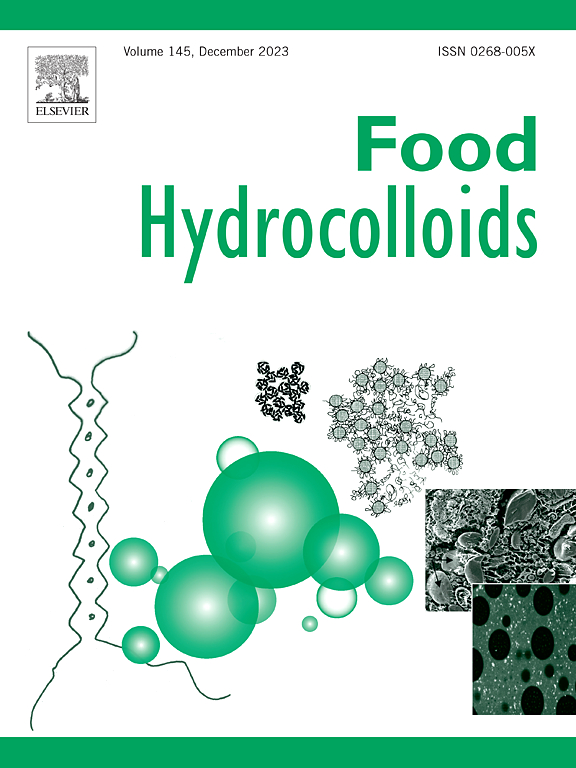通过改变油滴特性来调节填充乳清蛋白水凝胶的凝胶强度:理论与实验
IF 11
1区 农林科学
Q1 CHEMISTRY, APPLIED
引用次数: 0
摘要
基于蛋白质的水凝胶广泛用于食品,包括甜点、糖果、调味品、涂抹剂和肉类类似物。对于许多应用,重要的是调节水凝胶的纹理属性,使其满足消费者的期望。本研究考察了油滴特性,特别是油滴的大小和浓度对填充乳清蛋白水凝胶的流变性能的影响。实验测量结果与理论模型对分散在固体基体内的非稀球形流体颗粒填充复合材料弹性性能的预测结果进行了比较。该理论预测,填充水凝胶的机械强度会随着油滴浓度的增加而增加或降低,这取决于油滴的大小。小液滴具有很高的拉普拉斯压力,这使它们更能抵抗变形。因此,当它们的有效刚度高于周围蛋白质网络时,它们可能会增加凝胶强度。相比之下,大液滴具有较低的拉普拉斯压力,这使得它们极易变形。因此,它们往往会降低凝胶强度。在本研究中,我们制备了具有不同平均液滴直径的水包油乳剂,然后用它们形成具有一定液滴和蛋白质浓度的热固乳清蛋白凝胶。理论和实验显示了良好的定性一致性,但定量一致性较差,这是由于实际乳液凝胶不符合用于推导理论模型的假设。即便如此,这个数学模型对于理解和预测填充食物凝胶的行为还是有用的。本文章由计算机程序翻译,如有差异,请以英文原文为准。

Modulating the gel strength of filled whey protein hydrogels by altering oil droplets characteristics: Theory and experiments
Protein-based hydrogels are used in a wide range of food products, including desserts, confectionary, dressings, spreads, and meat analogs. For many applications, it is important to modulate the textural attributes of the hydrogels so that they meet consumer expectations. In this study, the impact of oil droplet characteristics, especially size and concentration, on the rheological properties of filled whey protein hydrogels was examined. The experimental measurements were compared to the predictions made by a theoretical model for the elastic properties of filled composite materials consisting of non-dilute spherical fluid particles dispersed within a solid matrix. This theory predicted that the mechanical strength of filled hydrogels can either increase or decrease with increasing oil droplet concentration depending on the size of the droplets. Small droplets have a high Laplace pressure, which makes them more resistant to deformation. Consequently, they may increase the gel strength when their effective rigidity is higher than that of the surrounding protein network. In contrast, large droplets have a low Laplace pressure, which makes them highly susceptible to deformation. As a result, they tend to reduce the gel strength. In this study, we prepared oil-in-water emulsions with different mean droplet diameters and then used them to form heat-set whey protein gels with a range of droplet and protein concentrations. The theory and experiments showed good qualitative agreement but there was a poor quantitative agreement, which was attributed to the fact that the real emulsion gels did not conform to the assumptions used to derive the theoretical model. Even so, this mathematical model is useful for understanding and predicting the behavior of filled food gels.
求助全文
通过发布文献求助,成功后即可免费获取论文全文。
去求助
来源期刊

Food Hydrocolloids
工程技术-食品科技
CiteScore
19.90
自引率
14.00%
发文量
871
审稿时长
37 days
期刊介绍:
Food Hydrocolloids publishes original and innovative research focused on the characterization, functional properties, and applications of hydrocolloid materials used in food products. These hydrocolloids, defined as polysaccharides and proteins of commercial importance, are added to control aspects such as texture, stability, rheology, and sensory properties. The research's primary emphasis should be on the hydrocolloids themselves, with thorough descriptions of their source, nature, and physicochemical characteristics. Manuscripts are expected to clearly outline specific aims and objectives, include a fundamental discussion of research findings at the molecular level, and address the significance of the results. Studies on hydrocolloids in complex formulations should concentrate on their overall properties and mechanisms of action, while simple formulation development studies may not be considered for publication.
The main areas of interest are:
-Chemical and physicochemical characterisation
Thermal properties including glass transitions and conformational changes-
Rheological properties including viscosity, viscoelastic properties and gelation behaviour-
The influence on organoleptic properties-
Interfacial properties including stabilisation of dispersions, emulsions and foams-
Film forming properties with application to edible films and active packaging-
Encapsulation and controlled release of active compounds-
The influence on health including their role as dietary fibre-
Manipulation of hydrocolloid structure and functionality through chemical, biochemical and physical processes-
New hydrocolloids and hydrocolloid sources of commercial potential.
The Journal also publishes Review articles that provide an overview of the latest developments in topics of specific interest to researchers in this field of activity.
 求助内容:
求助内容: 应助结果提醒方式:
应助结果提醒方式:


